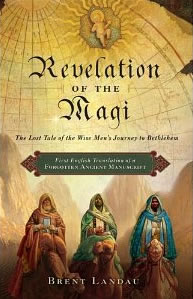Book Notes
 Brent Landau, translation and introduction, Revelation of the Magi (New York: HarperOne, 2010), 157pp.
Brent Landau, translation and introduction, Revelation of the Magi (New York: HarperOne, 2010), 157pp.
Almost everyone has heard of the three "wise men from the east" who followed the star and offered their gifts to the Christ child. But almost no one, says Brent Landau, including specialists, had ever heard of Revelation of the Magi — "a lengthy narrative that claims to be the personal testimony of the magi themselves on the events of Christ's coming. Though versions of this legend were well known in Christian Europe throughout the Middle Ages, this book presents the first-ever complete English translation."
Landau stumbled across a mention of Revelation of the Magi in a journal article, and ended up writing his 2008 Harvard dissertation on it. The only known copy of the manuscript is an eighth-century Syriac text from the Zuqnin monastery in southeastern Turkey. This Syriac text was somehow taken to an Egyptian monastery, where it was discovered in the 18th century by G.S. Assemani of the Vatican Library (where it resides today). The Revelation is mentioned in the fifth-century Latin commentary on Matthew called Opus Imperfectum in Matthaeum, although Landau argues for dating it to the late second or early third century. The location and identity of the author are unknown.
Written as an intricate and complex first person narrative of thirty-two short "chapters" (about 50 pages), the story doesn't follow Matthew's gospel in Matthew 2:1–12 in any meaningful sense. In this telling, the magi are not wise men but rather descendents of Seth who are known for their praying in silence. From their ancestor Seth the magi received the ancient prophecy of the star child, which prophecy was fulfilled in their own day. The name of the star child, Jesus Christ, is never mentioned, except in the last few pages of the text, where it's mentioned almost twenty times. This leads Landau to view the ending, where the magi are baptized by Thomas, as a later addition or "correction."
When Landau turns from history to theology, he suggests that the main contribution of Revelation of the Magi is its unusually positive view of religious pluralism. Jesus is manifested to people all over the world but never identified. In Landau's interpretation, all forms of religious belief are revelations of Jesus, which in turn makes evangelism superfluous. "I am everywhere," says Jesus in the text, "there is no land in which I am not." Indeed, the language is universalizing. The star child brings peace, joy and healing to "every human being," to "all the worlds" (plural form mentioned at least five times by my count), to the "entire world," and to "all the creatures of the world." The fifty pages of text are preceded by a thirty-page introduction, and followed by a brief conclusion, forty pages of end notes, and a short bibliography.


